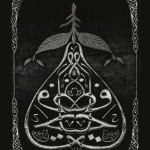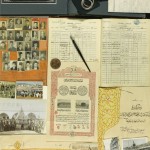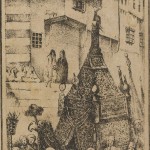In addition to a nuts and bolts quantitative analysis of the more recent material from the MacDonald surveys, I’m also interested in how the ways in which people inhabit a landscape are reflected in contemporary historical sources. Khirbet Sheikh ‘Isa (SGNAS 4) and al-Rujoum (SGNAS 45), which were both investigated as part of the Southern Ghors and Northeast ‘Arabah Archaeological Survey, have been identified with the medieval town of Zughar mentioned by several geographers. MacDonald suggests that Khirbet Sheikh ‘Isa was the Byzantine town known as Zoara, and Donald Whitcomb follows up with a discussion of the possibility that al-Rujoum was Zughar.
The tenth-century geographer Muqaddasi wrote of Zughar (or Sughar), the capital of al-Sharat (better known as Edom):
The people of the two neighboring districts call the Saqar (that is, “Hell”); and a native of Jerusalem was wont to write from here to his friends, addressing “From the lower Saqar (Hell) unto those in the upper Firdus (Paradise).” And verily this is a country that is deadly to the stranger for its water is execrable; and he who should find that the Angel of Death delays for him, let him come here, for in all Islam I know not of any place to equal it in evil climate…
Its people are black-skinned and thick-set. Its waters are hot, even as though the place stood over Hell-fire. On the other hand, its commercial prosperity makes of it a little Basra, and its trade is very lucrative. The town stands on the shore of the Overwhelming Lake [the Dead Sea] and is in truth the remnant of the cities of Lot, being the one that was spared by reason that its inhabitants knew nothing of their abominations. The mountains rise up near by the town.
From LeStrange 1896, 62-63 as quote in MacDonald et al. 1992, 116-117.
There is much to unpack in this little description. The invocation of the cities of Lot should alert us to the fact that there are literary tropes structuring Muqaddasi’s encounter with the place, although even these tropes may provide a glimpse of the affective power of the landscape and climate. The sarcastic epistolary reference to the town as Hell would appear to be a comment on its climate and landscape: the area south of the Dead Sea is incredibly hot, and the water of the Dead Sea is not only improbably salty but also, especially in the summer, very warm. But it might also be a subtle commentary on the backwards culture of the town as seen through the eyes of a metropolitan outsider.
Not only is the region deadly, but the climate is “evil.” I’ve been thinking about the essentializing rhetoric of geographers in which the affect and temperament of people are enfolded within a descriptive context of a specific place and climate (what Deleuze might call a haecceity) ever since I read Karl Steel’s mini-post on Mandeville over at In the Middle. Sidestepping the question of race in the Middle Ages, Karl considers the causal connection that Mandeville implies between climate and personality as a potentially disruptive repositioning of agency and responsibility: “The Tartars are bad like the weather is bad.” But the “evil climate” of Zughar, which could, Muqaddasi points out, result from a physical position relative to “Hell-fire,” does not necessarily produce bad people. Although Muqaddasi states that Sodom and Gomorrah were located in the same quasi-infernal region, their destruction (and the decision to spare Zughar as an urban island of innocents in a debauched network of cities and towns) has cleared the way for a flourishing economic center, “a little Basra.”
For more on the term saqar, we can turn to the Encyclopedi of the Qurʾān entry for “Hell and Hellfire” by Rosalind W. Gwynne, who lists it among the 10 or so names for Hell mentioned in the Qurʾān:
saqar is not defined at its first occurrence in Q 54:48 (“taste the touch of saqar”) but Q 74:26-31 contains a functional definition: it “lets nothing remain and leaves nothing alone, turning human beings red” ( lawwāḥatun lil-bashari, see Ṭabarsī, v, 386-9)
Extreme heat and bothersome or outright deadly wildlife are the two key components of hell, and both are found in the area south of the Dead Sea. Vegetation (gardens) and water (rivers) are both identified with paradise, and these are generally absent from the region (although relatively abundant in the Jordan Valley, and less scarce on the nearby Kerak plateau).
While Karl reads Mandeville’s description of the Tartar’s environment as a non-human agent actively shaping the personalities of its inhabitants, what can we do with the prosperous, “black-skinned, thick-set” people of Zughar who lucked out when Sodom was destroyed but who still live in a region that is, in the summer at least, Hellish? Even their skin color implies that they are like the sinners punished in the Qur’ān with black faces. Could it be the other way around, that the wicked people of al- Muʾtafikāt contaminated the landscape itself with their vile deeds, rendering it permanently hellish for future generations? Perhaps there a kind of moralizing eco-criticism at work in Muqaddasi’s description of Zughar and its hinterland.
Sources:
Gwynne, Rosalind W. “Hell and Hellfire.” Encyclopaedia of the Qurʾān. General Editor: Jane Dammen McAuliffe, Georgetown University, Washington DC. Brill, 2011. Brill Online. Bryn Mawr College. 09 May 2011.
MacDonald, Burton, and Khairieh ʼAmr. The Southern Ghors and Northeast ʼArabah Archaeological Survey. Sheffield: J.R. Collis Publications, 1992.
Al-Muqaddasi. The Best Divisions for Knowledge of the Regions (Ahsan al-taqasim fi maʻrifat al-aqalim). Translate by Basil Anthony Collins. Reading, UK: Centre for Muslim Contribution to Civilization, 1994.








